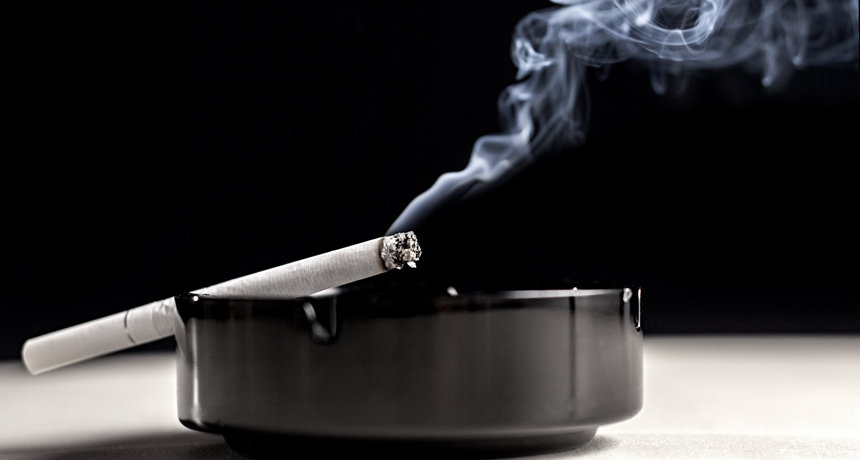Studies report new risks to teens from secondhand smoke
The pollution seems to boost risk of subtle immediate harm — then early death from lung disease as adults

Lingering cigarette smoke can be inhaled by others. Teens who breathe this in may become more susceptible to disease now, then face a higher risk in adulthood from lung disease.
Tonkovic/iStockphoto
No surprise: Smoking is bad for your health. But even people who never touch a cigarette can be harmed by cigarette smoke. They merely have to inhale the airborne pollutants exhaled by a smoker. That so-called secondhand smoke can linger in the air for days. Teens who can’t avoid breathing it in may develop coughing and trouble breathing. But even those who don’t may still suffer, a new study finds. And that’s not the worst of it. Another study found that in teens exposed to that smoke for years, far more serious lung disease may develop.
Some 9.6 million U.S. teens and preteens are exposed to secondhand smoke, which can aggravate asthma. That’s a lung disease that can make it hard to breathe. Most secondhand-smoke studies focus on teens with asthma. But Ashley Merianos, a tobacco researcher at the University of Cincinnati in Ohio, wondered if this pollution might hurt other kids, too. To find out, her team decided to look at overall sickness rates in these kids. They also tracked their school attendance rates.
The researchers used data from a national survey known as PATH. (It stands for Population Assessment of Tobacco and Health.) Every year since 2011, the U.S. Department of Health and Human Services has surveyed people 12 and up about the effects of tobacco on their health. Its findings help guide government policies to protect public health.
Merianos’ team focused on PATH data from 2014 and 2015 for kids ages 12 to 17. That covered 7,389 adolescents. Each kid had been asked if they lived with someone who smoked. They also were asked how much time they were exposed to smoke in a typical week.
Other questions asked whether they generally felt short of breath, or did they have a dry cough at night. Each kid reported whether they visited the emergency room that year, and if so, how often. Finally, each participant estimated how often they missed school over the past year for medical reasons.
Many things affect our health. So linking effects to particular causes is not easy. Yet researchers must try to account for this when designing a study. Here, Merianos’ team took one step by excluding any teens with asthma. They also excluded those who had smoked cigarettes within 30 days of taking the survey. That helped the researchers home in on teens who had been generally been healthy.
Some of these kids reported no regular exposure to secondhand smoke. And compared to them, those who lived with smokers or encountered secondhand smoke at least an hour each week were more likely to report health issues. During or after exercise, for instance, they were more likely to suffer from shortness of breath and wheezing. They also reported more days off sick from school.
The team published its findings in the August Pediatrics.
Long-term consequences
Ryan Diver works for the American Cancer Society (ACS) in Atlanta, Ga., where he usually studies the causes of cancer. But he was intrigued by the report’s finding that teens living with smokers are likely to have poor lung function. He suspected that inhaling smoke as a kid might lead to lifelong lung problems. So his team decided to mine data from a large study of adults to see if there were any signs this might be true.
These researchers used data from a large ACS cancer-prevention study. Roughly 70,000 people between the ages of 50 and 74 took part. None had ever smoked. The study took place at two different times. In 1992, the volunteers reported if they had ever been exposed to smoke regularly as a child. After 22 years, the survey look at the recruits’ health. About one-third had died. The study noted the reported cause.
Diver’s team then looked at whether certain causes of death were more likely among those people who had been exposed to secondhand smoke as children. And they found such people were more likely to have died from lung disorders. The researchers published their findings in the August American Journal of Preventive.
A 2014 health report by U.S. government had suggested that secondhand exposure to smoke could have long-term adverse effects, notes Merianos. The data by Diver’s team now supports that suspicion, she says.
Together, the new studies suggest that passive smoking may hurt teens’ health in multiple ways. Adults should avoid smoking around adolescents, says Merianos. And for teens, not smoking is a good first step. But it may also be important to limit time around peers and others who do light up.







